EFLOW eFlow E3Nitro Owner's manual
- Category
- Bicycles
- Type
- Owner's manual
This manual is also suitable for

E3NITRO
Electric Bicycle
Owner’s Manual
Currie Technologies®
3850A Royal Avenue, Simi Valley, CA 93063
eflowebike.com | currietech.com
Version 101
Last modied: April 4, 2013 10:54 AM
Owner's Manual - eFlow E3Nitro.indd

Contents
Section 1 Introduction .....................3
Section 2 Important safety information .....4–7
Important symbols and terms .........6–7
Section 3 Recording your bicycle’s important
serial numbers ...................8
Section 4 Specications .................9–11
Bicycle ...........................9–10
Battery ..........................10–11
Section 5 eFlow component chart .........12
Section 6 Prior to your rst ride ..........13–22
Installing a quick release
front wheel .......................15–17
Adjusting a quick release
seatpost clamp ...................17–19
Section 7 Operation ................... 23–38
Installing & removing the battery ....23–24
How to ride. . . . . . . . . . . . . . . . . . . . . . . . . . 25
Operating modes ....................26
Display details ....................27–35
Gears & shifting ...................35–36
Range & tips .....................37–38
Section 8 Battery care .................39–45
Charging ........................ 40-43
Storage ..........................43–44
Disposal ............................44
Section 9 Troubleshooting ..............45–48
Flat tire ..........................46–50
Currie Tech Technical and Customer Service: +1 800-377-4532 p. 2/52

I. Introduction: A word about this Owner’s Manual and your
safety…
Dear Customer,
Currie Tech would like to thank you for purchasing our product.
Cycling (electric or otherwise) can be a hazardous activity,
no matter what type of bicycle you ride. Trafc, weather,
distractions, and many other factors can endanger you while
using any type of bicycle or vehicle. Mistakes and accidents
can lead to severe injury or death so please read this manual
before riding our product.
You have a responsibility to learn how to operate your new
bicycle safely and correctly. Keep it in good shape by
maintaining it and making sure that anyone who uses it knows
how to operate it safely.
Please take the time to read and understand the following
warnings and cautions. Throughout this manual we will attempt
to reinforce the guidelines that we have summarized below.
This is important. If others use your bicycle, please show this
section to them so that they are aware of these important
guidelines to help avoid accidents and reduce the severity of
injuries when they occur.
Thank you.
p. 3/52

II. Important Safety Information
• Helmets: There is no single factor that works better at
reducing the severity of injuries sustained in bicycle
accidents more than a quality bicycle helmet. Please
don’t ever ride your bicycle without one.
• It’s not a tandem: Your bicycle was engineered to carry
one (1), [that is a single rider,] person safely. The rack on
the back is for luggage or a battery. Overloading the
bicycle with a second rider is a bad idea that can lead to
severe injury or death! Not to mention the fact that you
will severely impact the performance of the bicycle.
• It’s the law; obey it: Obey all trafc laws. Always ride
on the right side, with, not against, trafc. STOP signs
and trafc lights apply to cyclists as well as cars and
pedestrians.
• Be alert to conditions around you! Unfortunately, a
motorist that has successfully parallel parked his/her car
is not always thinking about the cyclist fast approaching
from behind. An impact with a car door suddenly
opened into your path will ruin your day.
• Weather: If you get caught in rain or snow, please be
aware that distance to stop your bicycle may double or
triple over the distance that it takes under dry conditions.
Ride more slowly and anticipate your stops by applying
the brakes MUCH earlier. Don’t forget that the roads are
a lot more slippery when wet. Bicycle tires don’t grip wet
pavement as well as dry pavement. Take the corners
carefully.
Currie Tech Technical and Customer Service: +1 800-377-4532 p. 4/52

• Night time: Motorists have a hard time seeing you when
the sun goes down. We make the bicycle easier to see
with reectors, and you can help with additional lights
and strobes (available accessories). However, even with
these additional features, you’re still not as visible as in
the daytime. If you must ride at night, wear light-colored
clothing, preferably with reective strips. Buy a ashing
LED light and use it. Make sure that the reectors on
your bicycle are properly positioned and clean. Use the
headlight so that you can see the obstacles in your path.
Ride more slowly. Be wary of cars and assume that they
do not see you.
• Maintenance: It worked ne when we put it in the
box: Please maintain your bicycle. We have included
maintenance instructions in this manual. We’re smart
guys, but we haven’t gured out how to make a bicycle
that takes care of itself. Check the brakes and the tires
and the tightness of all those important fasteners before
each and every ride. Pretend that you’re a pilot doing
a walk-around of his airplane before taking-off. The pilot
knows that his life depends on the airworthiness of his
plane; your life depends on the roadworthiness of your
bicycle. Please have your bicycle checked by a qualied
bicycle mechanic AT LEAST once a year. It’s a small
investment in your well-being.
• Battery: We have equipped your eFlow bicycle with a
state-of-the-art lithium ion battery. This is the same battery
chemistry that powers your cell phone and laptop, but
on a much bigger scale. Lithium ion batteries feature the
highest gravimetric energy density available. (How’s that
for engineering techno-speak? What it means is that you
get more energy per pound than with any other battery
chemistry.) We have built-in a sophisticated battery
management system (BMS) that helps control all that
p. 5/52

energy. But the battery requires care and maintenance
to ensure that it will perform safely and reliably for many
miles of riding. We have devoted an entire chapter of
this manual to the battery. Please read and understand
this important information. As always, if you have any
questions, please don’t hesitate to contact us.
If you have a question about any aspect of riding your bicycle,
please don’t hesitate to give us a call. We love to talk about
the safe use of our products. Or call the Authorized Dealer
where you purchased the bicycle. Remember, we love to do
anything that we can to make sure that you remain a healthy
and loyal customer.
IN SUMMARY:
1. WEAR A HELMET EACH AND EVERY TIME YOU GET ON THE
BICYCLE!
2. Don’t carry passengers.
3. Obey the Rules of the Road.
4. Ride defensively! Watch out for both moving and
stationary cars.
5. Be careful in wet conditions. Braking and traction are
signicantly reduced.
6. Ride carefully at night and make sure you are wearing
high visibility reective clothing.
7. Maintain your bicycle.
8. Care for your battery.
9. Read and study the rest of this manual.
10. If you do not understand any aspect of the use and care
of your bicycle, PLEASE call us: Currie Tech Customer
Service: (800-377-4532).
Important Symbols and Terms
This Owner’s Manual uses the following symbols and terms to call
your attention to Warnings, Cautions and Notes:
Currie Tech Technical and Customer Service: +1 800-377-4532 p. 6/52

Term: WARNING
Meaning: This term calls attention to a Warning. A
Warning indicates a potentially hazardous situation,
which if not avoided, could result in bodily injury or
death, in addition to property damage. Read the text
accompanying the warning to be aware of the specic
hazard.
Term: CAUTION
Meaning: This term calls attention to a Caution. A
Caution indicates a potentially hazardous situation, which
if not avoided, may result in damage to equipment or
inadvertent system failure. Read the text accompanying
the Caution to be aware of the specic hazard and avoid
damage or system failure.
Term: Note:
Meaning: This term calls attention to a Note. The text
accompanying a Note provides helpful or other important
related information.
Please read, understand and follow all Warning, Caution
and Note notices on your eFlow bicycle and those
included in this Manual. If you do not understand any
of this important information, please contact your selling
dealer or the Currie Tech Customer Service Department
at 800-377-4532.
Related Manuals: Many of the components that are installed
on your eFlow bicycle have manuals that provide operating
and maintenance instructions regarding those particular
components. Please read and understand the important
information contained in those manuals as well.
p. 7/52

III. Recording Your Bicycle’s Important Serial
Numbers:
Your bicycle and certain key components have unique serial
numbers. We urge you to record these serial numbers for
warranty purposes or in case your bicycle is ever lost or stolen.
Bicycle: The bicycle’s serial number is located on the underside
of the frame near the pedal crank:
Bicycle serial number: ______________________________
Motor: The motor serial number is on a label attached to the
left side of the motor hub:
Motor serial number: _____________________________
Battery: The battery serial number is on a label afxed to the
right side of the battery:
Battery serial number: _____________________________
Please also record this other important information:
Date of Purchase: ______________________________
Selling Dealer: ______________________________
Street Address: ______________________________
City/State/Zip: ______________________________
Telephone: ______________________________
Salesman: ______________________________
Please keep this information in a safe place for future reference.
Currie Tech Technical and Customer Service: +1 800-377-4532 p. 8/52

IV. Specications*
• Performance
o Maximum speed: 20 miles/hour (32 kilometers/
hour)*
o Maximum range: Up to 20 miles (32 kilometers)*
(with standard battery pack)
o Maximum Weight: 275 lbs (125 kilograms)
*Note: many factors affect speed and range
capabilities of the eFlow bicycle. Terrain, average
speed, rider weight, tire ination pressure, winds, hills,
etc., all have an impact on how far and how fast you
go. Please see the Operations section of this Owner’s
Manual for more details.
• Operating modes
o Power-On-Demand Mode (POD): Motor power
regulated by a twist-grip throttle
o Pedal Assist Mode (PAS): Motor power proportional
to rider pedaling effort
• Bicycle
o Frame Aluminum
o Frame size 14.5”
o Front fork: RST SS-A6-T shock front fork
o Handlebar: Kalloy FB-13
o Handlebar stem: Kalloy AS-025
o Grips: Velo VLG-311
o Rims: 26” Alex FR-30 aluminum
o Tires: Maxxis M2003 26” x 2.0”
o Tubes: CST 26” x 2.0”
o Front derailleur SRAM Apex (2 x 10)
o Rear derailleur SRAM Apex (10 speeds)
o Shifters SRAM SL700 Flatbar trigger
o Front brake: Tektro AURIGA E-SUB 51M
o Rear brake Tektro AURIGA E-SUB 51S
o Saddle: Velo VLG-311
p. 9/52

• Motor
o Type: TDCM brushless, gearless hub motor
o Power rating: 500-watts
• Standard Battery Pack
o Model: HTEnergy
o Chemistry: Lithium Ion
o Conguration: 10S5P, 2.2 Amp-hr 18650 cells
o Rated voltage: 37 Volts
o Rated capacity: 11Ah (407 watt-hrs)
o Weight: 3.9 kg (8.6 lbs)
o Max discharge current: 26A
o Over-discharge limits: 2.30V±0.025V per cell
o Pack cut-off voltage: 30V±4V
o Charge method: Constant Current/Constant Voltage
o Over-charge limits: 4.25V±0.025V per cell
o Max charge current: 5A (0.5C5)
o Max charge voltage: 42V
o Internal resistance: ≤150mΩ
• Optional, High Capacity Battery Pack
o Model: HTEnergy
o Chemistry: Lithium Ion
o Conguration: 10S8P, 2.2 Amp-hr 18650 cells
o Rated voltage: 37 Volts
o Rated capacity: 17.6Ah (634 watt-hrs)
o Weight: 5.2 kg (11.4 lbs)
o Max discharge current: 26A
o Over-discharge limits: 2.30V±0.025V per cell
o Pack cut-off voltage: 30V±4V
o Charge method: Constant Current/Constant Voltage
o Over-charge limits: 4.25V±0.025V per cell
o Max charge current: 5A (0.5C5)
o Max charge voltage: 42V
o Internal resistance: ≤150mΩ
Currie Tech Technical and Customer Service: +1 800-377-4532 p. 10/52

• Charger
o Model: HP8204L3(10S)/36V2A
o Dimensions: 188mm x 93mm x 53mm
o Weight: 850g (1.8lb)
o Input voltage: AC110V~264V/47~63HZ
o Output voltage: 42±0.5VDC
o Output amperage: 2.0±0.2A
o AC line fuse rating: 10 amp
*Note: Specications are subject to change without notice.
p. 11/52

V. eFlow Component Chart
1. Saddle (seat)
2. Seat post/Battery pack
3. Quick-release seat post clamp
4. Adjustable handlebar stem
5. Throttle
6. Display
7. Front tire/wheel
8. Front disc brake
9. Pedal
10. Crank arm
11. Chain ring
12. Kick stand
13. Drive chain
14. Rear tire/wheel
15. Rear derailleur
16. Rear disc brake
17. Rear hub motor
1
2
3
4
5
6
7
8
9
11
12
14
15
16
17
13
10
Currie Tech Technical and Customer Service: +1 800-377-4532 p. 12/52

VI. Prior to your rst ride
IMPORTANT NOTICE: All Currie Tech products are intended to be
delivered in a completely assembled and adjusted condition.
To ensure your total satisfaction, the agreement that we sign with
our dealers prohibits the sale of an unassembled Currie Tech
product. If you are sold an unassembled Currie Tech vehicle,
please call our Customer Service Department at (800) 377-4532.
WARNING: There are no user serviceable elements
incorporated into the motor, motor controller, battery, battery
charger, throttle, or wiring harness of your Currie Tech electric
bicycle. DO NOT ATTEMPT TO DISASSEMBLE OR ADJUST ANY OF
THESE COMPONENTS. Doing so may cause extensive damage
to these components, will void your warranty, and may cause
a hazardous condition. If you cannot resolve a problem using
the troubleshooting guide in Chapter IX, contact your Currie
Tech authorized dealer, or call the Currie Tech Customer Service
Department at (800) 377-4532 for assistance.
Note: Throughout this manual, we will refer to the “right side”
and the “left side” of the bicycle. For clarication purposes,
“left” and “right” are relative to your position when sitting on the
bicycle in the normal riding position.
Note: It is important to fully charge the battery prior to rst
use. Unpack the battery and battery charger, and charge the
battery (per the instructions found in Section VIII of this manual)
for at least 8 hours before using the bicycle for the rst time.
Before you ride:
Use the following checklist to ensure that your eFlow bicycle is
ready for safe and enjoyable use.
• Quick releases: Make sure that the front wheel quick
release and seat height adjustment quick release are
properly adjusted and tight.
p. 13/52

WARNING: Failure to properly adjust and lock the front
wheel quick release may result in the inadvertent separation
of the front wheel while you are riding the bicycle. This
occurrence can result in serious injury or death, and property
damage. Please refer to the instructions below for the
proper installation and adjustment of the front quick release
hub. If you are uncertain about any aspect of the assembly
and adjustment of your bicycle, seek help from a qualied
bicycle mechanic or the Currie Tech Customer Service
Department at (800) 377-4532.
Your eFlow bicycle uses quick release (QR) levers to facilitate
common tasks such as front wheel removal and seat height
adjustment.
When properly adjusted, quick release levers are both safe
and convenient, but you must understand and apply the
correct technique to adjust them properly before riding your
bicycle to prevent serious injury or death from a fall.
Quick release levers use a cam action to clamp the wheel
or other components in place. Because of their adjustable
nature, it is critical that you understand how they work, how
to use them properly, and how much force you need to
apply to secure them.
Warning: The full force of the cam action is needed to clamp
the wheel or other components securely. Holding the nut
with one hand and turning the lever like a wing nut is NOT
a safe or effective way to close a quick release and will not
clamp the wheel or other components safely.
Currie Tech Technical and Customer Service: +1 800-377-4532 p. 14/52

WHEEL QUICK RELEASE USAGE
Riding with an improperly adjusted wheel quick release can
allow the wheel to wobble or fall off the bicycle, which can
cause serious injury or death.
Therefore, it is essential that you:
1. Ask your dealer or a local bike shop to help you make
sure you know how to install and remove your wheels
safely.
2. Understand and apply the correct technique for
clamping your wheel in place with a quick release.
3. Each time, before you ride the bike, check that the
wheel is securely clamped.
Installing a quick release front wheel
In a quick release system, the wheel hub is clamped in
place by the force of the quick release cam pushing against
one dropout and pulling the tension-adjusting nut, by way
of the skewer, against the other dropout. (Please refer to
the illustrations below.) The amount of clamping force is
controlled by the adjustment of the tension-adjusting nut.
Turning the tension-adjusting nut clockwise while keeping
the cam lever from rotating increases clamping force;
turning it counterclockwise while keeping the cam lever from
rotating reduces clamping force. Less than half a turn of the
tension-adjusting nut can make the difference between safe
clamping force and unsafe clamping force.
p. 15/52

1. Remove the tension adjusting nut and one of the small
springs, then slide the quick release skewer through the hub.
If your bicycle has a disc brake, insert the skewer starting on
the side with the brake rotor. Replace the spring and tension
adjusting nut (g. a).
2. If your bicycle has rim brakes, disengage them to increase
the clearance between the tire and brake pads.
3. Install the wheel into the dropouts, making sure the quick
release lever is on the left side of the bicycle.
4. Holding the quick release lever in the OPEN position with
one hand, tighten the tension adjusting nut with your other
hand until it is nger tight against the fork dropout.
5. While pushing the wheel rmly to the top of the slots in the
fork dropouts, and at the same time centering the wheel rim
in the fork, move the quick release lever upwards and swing
it into the CLOSED position (gs. b & c) The lever should now
be parallel to the fork blade and curved toward the wheel.
To apply enough clamping force, you should have to wrap
your ngers around the fork blade for leverage, and the lever
should leave a clear imprint in the palm of your hand.
Currie Tech Technical and Customer Service: +1 800-377-4532 p. 16/52

WARNING: Securely clamping the wheel takes considerable
force. If you can fully close the quick release without
wrapping your ngers around the fork blade for leverage,
and the lever does not leave a clear imprint in the palm of
your hand, the tension is insufcient. Open
the lever; turn the tension adjusting nut clockwise a quarter
turn; then try again.
6. If the lever cannot be pushed all the way to a position
parallel to the fork blade, return the lever to the OPEN
position. Then turn the tension-adjusting nut counterclockwise
one-quarter turn and try tightening the lever again.
7. Re-engage the brake to restore correct brake pad-to-rim
clearance; spin the wheel to make sure that it is centered
in the frame and clears the brake pads; then squeeze the
brake lever and make sure that the brakes are operating
correctly.
WARNING: An improperly secured seat post could lead
to loss of control of the bicycle while riding, causing an
accident that may result in serious injury or death, and
property damage. If you are not sure how to properly
adjust and apply the quick release seat post clamp, please
consult your authorized Currie Tech dealer, or the Currie
Tech Customer Service Department at (800) 377-4532 for
additional instructions.
Adjusting a quick release seat post clamp
In a seat post quick release system, the seat post is clamped
in place by the force of the quick release cam pushing
against one side of the clamp and pulling the tension
adjusting nut, by way of the skewer, against the other. The
amount of clamping force is controlled by the tension-
adjusting nut. Turning the tension-adjusting nut clockwise
while keeping the cam lever from rotating increases
clamping force; turning it counterclockwise while keeping
p. 17/52

the cam lever from rotating reduces clamping force. Less
than half a turn of the tension-adjusting nut can make
the difference between safe clamping force and unsafe
clamping force.
1. With the quick release clamp in the OPEN position, insert
the seat post, with saddle attached, into the bicycle’s seat
tube. (Refer to the illustrations above.)
2. Swing the quick release lever into the CLOSED position.
3. Grab the saddle with both hands and attempt to push it
down.
4. If you are able to force the seat post further into the frame,
the seat post clamp needs to be adjusted. Holding the quick
release lever in the OPEN position with one hand, tighten the
tension-adjusting nut with your other hand about 1/2 turn
clockwise.
5. Attempt to swing the lever into the CLOSED position. If the
lever cannot be pushed all the way to the CLOSED position
(g. b), return the lever to the OPEN position, then turn the
tension adjusting nut counterclockwise one-quarter turn
and try tightening the lever again. Repeat steps 3, 4 & 5 until
Currie Tech Technical and Customer Service: +1 800-377-4532 p. 18/52

proper quick release tension is achieved.
Tires:
Bicycle tires normally lose pressure over time. An under
inated tire can cause premature tire failure, and will require
signicantly more energy (electric and human) to propel the
bicycle. Low tire pressure will have a signicant negative
impact on battery range. Ensure that both front and rear
tires are inated to the recommended tire pressure indicated
on the sidewall of the tire. Check the tires for any damage
or unusual wear. The tire should be properly seated in the rim
and the t of the tire bead in the rim should be periodically
checked. Ensure that the tire is not cracked or excessively
worn. Check for foreign objects in the tread, and that the
valve stem is straight in the rim. Damaged or worn tires
should be replaced immediately. Take the bicycle to a
qualied bicycle mechanic to repair and/or replace your
tires if necessary.
Reectors:
Your bicycle comes equipped with eight (8) reectors (front
handle bar, rear fender, front wheel, rear wheel and two
each on the left and right pedals) to make you more visible
at night. Please ensure that those reectors are in place,
properly positioned and clean before each ride.
Drive chain:
Your eFlow bicycle is equipped with a high quality roller
chain that needs to be cleaned and lubricated regularly.
p. 19/52

Brakes:
Check your brakes before each ride.
WARNING: Riding with brakes that are damaged,
excessively worn and/or misadjusted will signicantly
degrade the stopping capabilities of your bicycle. This
condition could lead to an accident resulting in serious
injury or death, and property damage. If you are uncertain
about any aspect of the assembly and/or adjustment of your
bicycle, seek help from a qualied bicycle mechanic or the
Currie Tech Customer Service Department at (800) 377-4532.
WARNING: Bicycle brakes lose effectiveness when wet.
Avoid riding in wet weather. If it is unavoidable, be aware of
the fact that stopping your bicycle will require extra distance.
Ride more slowly, keep a greater distance between yourself
and other trafc, and begin braking sooner than normal.
Failure to take these precautions could lead to an accident
causing serious injury or death, and property damage. If you
are uncertain about any aspect of the brake operation under
any condition, seek help from a qualied bicycle mechanic
or the Currie Tech Customer Service Department at (800) 377-
4532.
Test the function of your brakes by riding your bicycle in
an area free from trafc and obstructions prior to every
ride.
• Brake cut-off switches: To maximize the effectiveness
and efciency of the braking system, and to save
battery power, your eFlow bicycle uses a system that
turns power to the motor “OFF” when the brakes are
applied. Check the function of the brake cut-off
switches before each ride. To do so, turn the power
“ON”, set the Mode to POD (see below), lift the rear
wheel off the ground by pushing the bicycle onto the
lowered kickstand, and actuate the throttle.
Currie Tech Technical and Customer Service: +1 800-377-4532 p. 20/52
Page is loading ...
Page is loading ...
Page is loading ...
Page is loading ...
Page is loading ...
Page is loading ...
Page is loading ...
Page is loading ...
Page is loading ...
Page is loading ...
Page is loading ...
Page is loading ...
Page is loading ...
Page is loading ...
Page is loading ...
Page is loading ...
Page is loading ...
Page is loading ...
Page is loading ...
Page is loading ...
Page is loading ...
Page is loading ...
Page is loading ...
Page is loading ...
Page is loading ...
Page is loading ...
Page is loading ...
Page is loading ...
Page is loading ...
Page is loading ...
Page is loading ...
Page is loading ...
-
 1
1
-
 2
2
-
 3
3
-
 4
4
-
 5
5
-
 6
6
-
 7
7
-
 8
8
-
 9
9
-
 10
10
-
 11
11
-
 12
12
-
 13
13
-
 14
14
-
 15
15
-
 16
16
-
 17
17
-
 18
18
-
 19
19
-
 20
20
-
 21
21
-
 22
22
-
 23
23
-
 24
24
-
 25
25
-
 26
26
-
 27
27
-
 28
28
-
 29
29
-
 30
30
-
 31
31
-
 32
32
-
 33
33
-
 34
34
-
 35
35
-
 36
36
-
 37
37
-
 38
38
-
 39
39
-
 40
40
-
 41
41
-
 42
42
-
 43
43
-
 44
44
-
 45
45
-
 46
46
-
 47
47
-
 48
48
-
 49
49
-
 50
50
-
 51
51
-
 52
52
EFLOW eFlow E3Nitro Owner's manual
- Category
- Bicycles
- Type
- Owner's manual
- This manual is also suitable for
Ask a question and I''ll find the answer in the document
Finding information in a document is now easier with AI
Other documents
-
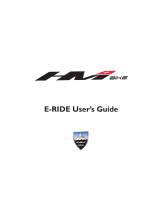 HM Bike E-Ride User manual
HM Bike E-Ride User manual
-
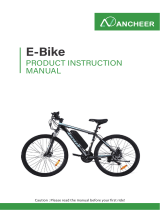 Ancheer AMA005637 26 Inch Wheel Electric Mountain Bike 250W User manual
Ancheer AMA005637 26 Inch Wheel Electric Mountain Bike 250W User manual
-
Voyager BIKE4050RP Radius Pro Electric Bike User manual
-
Hover-1 H1-MFEB Bicycle User manual
-
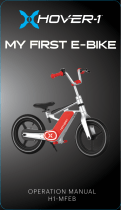 Hover-1 My first e-bike Owner's manual
Hover-1 My first e-bike Owner's manual
-
Currier Tech eZip TRICRUISER Assembly Manual
-
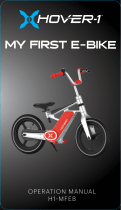 Hover-1 H1-MFEB My First Electric Bike User manual
Hover-1 H1-MFEB My First Electric Bike User manual
-
Currier Tech IZIP Owner's manual
-
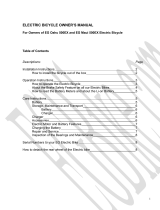 EG EG Maui 500EX Owner's manual
EG EG Maui 500EX Owner's manual
-
Currier Tech Ezip Trailz Assembly Manual
























































